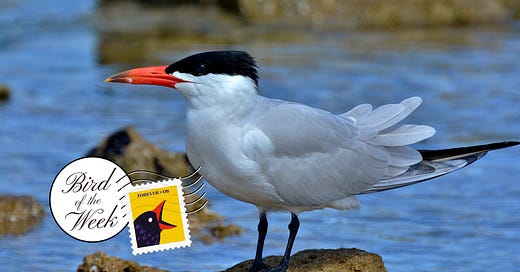
We’ve been on land for a good while in Bird of the Week, so today, we’re splashing back into the water, with the help of an Amazing Avian™: the Caspian tern.
Take a bow, buddy!
OK, I love this bird. It’s like someone took a seagull and gave it a much cooler head and beak and tail feathers. (Though the Caspian tern, the largest of all terns, is actually larger than some gulls, so maybe the seagull is the lesser Caspian tern rather than the tern being the greater seagull???)
Yes, stretch those wings!!! Master of all it surveys! The water bows down! The other tern looks on!!!
Unlike our last bird, the elusive lammergeier, you can practically reach out your hand anywhere and probably snag a Caspian tern if you wanted to. They “tern” up (wordplay!!) on coastlines and beaches on every continent except Antarctica. Freshwater? Saltwater? The Caspian tern’s not picky! It’ll take your oceans, your lakes, your streams and reservoirs and isthmuses and fjords. OK, maybe not the fjords, but the point is it likes all kinds of water—anywhere, really, where it can get at the source of almost all of its food, which is fish.
Not only do Caspian terns looooove fish—in an eating way, not a Shape of Water way, I hasten to add—they are also masters at getting fish. They have turned dive-bombing for food into a work of art. From Cornell’s All About Birds website:
To locate prey, they fly above water, between 10 and 100 feet high, and scan the water with bill pointed downward. When they spot prey they dive rapidly, usually submerging the body in the process but sometimes snatching the prey from the water without diving in. They usually consume fish in flight quickly after capture, unless the prey item is intended for the mate or chick.
Imagine plunging into the water to get your food and then eating it while you’re still flying.
The lethal grace this has…I’m speechless.
I mean….come on! (PS, GREAT shot, Nigel who took the picture.)
As the Cornell brains noted, sometimes the terns take the fish back to their mates. Here’s a cute video of that (well, cute for everyone except for the fish).
But the fish are also an integral part of the mating process itself. Again from All About Birds:
Almost immediately on return to nesting areas, Caspian Terns begin courtship displays. Males capture fish and fly back and forth by groups of other terns, showing off their prize. Small groups of both males and females may follow or chase the male in the air. The male eventually lands next to a female and presents the fish, nodding to her as he does. Receptive females usually accept the fish, sometimes giving a juvenile-like feeding display in which they hunch down, jerk the bill upward several times, and call. Males sometimes repeat this process with several females before pairing occurs.
I mean, it makes sense! Objectively speaking, a female tern knows that a male that can get a fish for her can probably get it for the kids if they have them.
Sometimes the female is not interested though, as in this sorry moment captured on film:
Ouch, rejected. Can you imagine that fish just sitting there while a bird tries to use it for sex and then it gets eaten? What a life.
That video is a good example of a Caspian tern colony—it enjoys being part of a neighborhood—and of the harsh but very compelling call the tern makes. I am also a huge fan of the way they bob their necks up and down.
Of course, lots of times mating does occur, which is nice for the baby terns, because terns are notably committed parents in bird terms. (Terns of endearment??? Wordplay!!)
Not only are terns attentive parents when their chicks are downy and flightless, they continue to feed their young into the fall as they stage for migration and move south. In fact, Sandwich Terns have been seen feeding fledglings on their wintering grounds, and Royal and Caspian Terns migrate with their young and may feed fledglings into late winter or early spring of the next year.
[…] The extra food tern parents provide has a serious side, though. While the fledglings take care of themselves and do catch their own food, mortality is higher for first-year terns than for adults of two or more years. Among Royal, Sandwich, and Caspian Terns estimates of first-year survivorship vary depending on the parameters of particular studies, but they range from less then 50% when chicks are included to around 80% when looking at chicks from fledging on. Meanwhile, rates of adult survivorship from year to year can exceed 90%. So, when adults can make the first winter easier for their offspring by extending the period of time they provide care, they might be giving them a crucial leg up.
Now that’s ten-tern loving care! (OK I don’t think that one worked as well.) Is there anything Caspian terns can’t do??? I’m going to say….NO. Keep on terning!
A reminder: you can check out our complete Bird of the Week list here, and get in touch with your bird suggestions at hello@discourseblog.com.





















I would like to suggest the honeyguide as a future Bird of the Week. They help people find honey! And then they get to have some honey! Cooperation!